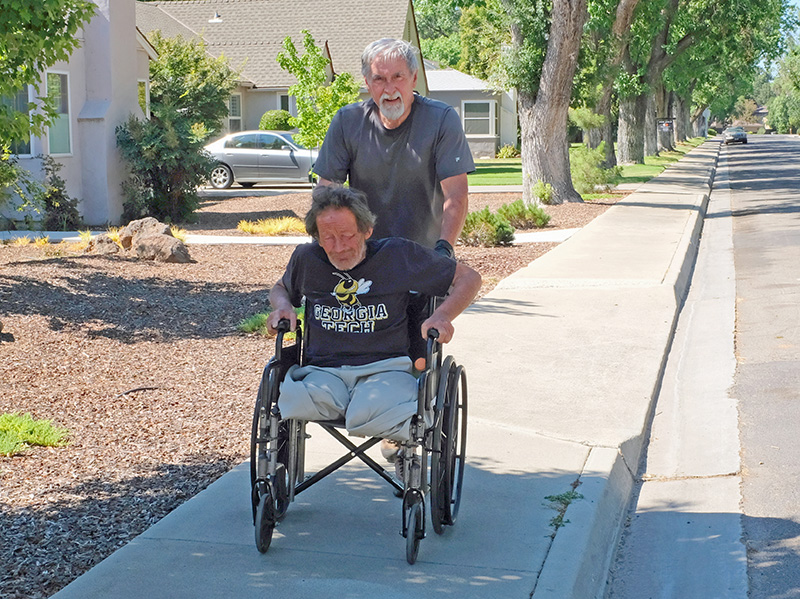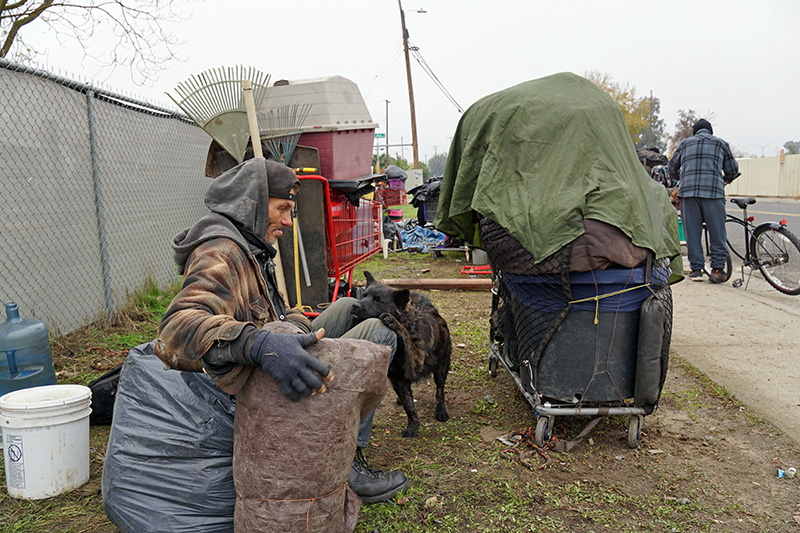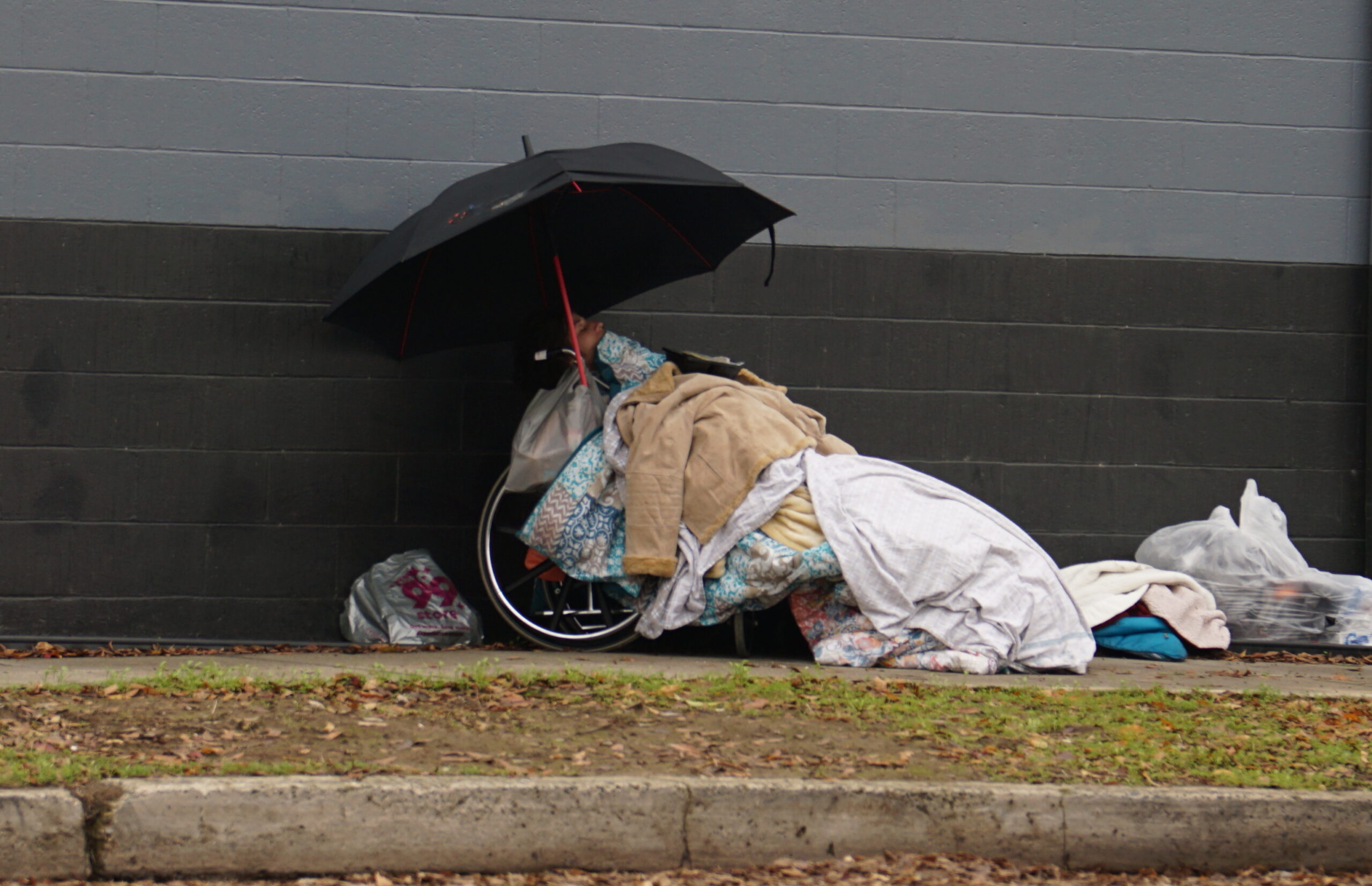Despite the expenditure of billions of dollars, homelessness in California continues to burgeon. While every city and county throughout the state faces different challenges trying to manage the problem, there are enough similarities that all can learn from one another’s failures. Stanislaus County and the City of Modesto offer typical examples of tactics that have failed again and again. ed
Frank Ploof may know more about homelessness in Stanislaus County and the City of Modesto than anyone else in the region. With over ten years’ on-the-ground experience dealing with homeless individuals and the county’s various systems of care, Ploof has also sat on many of the region’s various committees devoted to homelessness, housing, and behavioral health.
Recently he said, “What we call a system of care is a system of referrals. A true system of care for homelessness was never designed and should be for obvious reasons.”
Like many frustrated observers of people in dire need with nowhere to go, Ploof recently joined Modesto businessman Steve Finch in the formation of a nonprofit dedicated to filling some of the many gaps in the city’s and county’s overburdened systems of care.
The Stanislaus Homeless Advocacy and Resource Enterprise (SHARE) grew out of need and compassion. The need was for housing and shelter and the compassion was for people incapacitated by disability, age, illness, and poverty who had nowhere to go.
One of SHARE’s roles is to fill the gap between city and county “services” and placement of people in temporary, transitional, or permanent housing. Finch and Ploof are frequently called upon to provide motel rooms for people in immediate need of shelter that city and county agencies can’t or won’t provide.

While city and county officials insist there is always help available for anyone who wants it, the fact is that appropriate help and services for homeless people in need is often unavailable when they need it. A common case involves people recently released from hospitals when they’re well enough to leave the hospital, but can’t access appropriate shelter while recovering fully. Other cases might involve someone with a terminal illness awaiting entry into hospice care.
Ploof estimates there are at least thirty-five local nonprofits and government agencies dedicated to helping homeless people, yet homeless numbers keep growing. The most obvious problem is the lack of housing, but a greater issue is the lack of a homeless management plan.
In theory at least, Stanislaus County is responsible for managing behavioral health problems within county lines. In fact, the county doesn’t have sufficient capacity for managing behavioral health.
Well over a year ago, the Salvation Army’s Harold Laubauch said that, “Forty percent of our residents deal with mental health challenges and another 40 percent deal with substance abuse challenges.” Laubauch was referring to residents of Stanislaus County’s low barrier shelter; the Salvation Army has a contract to manage it.

Homeless people trying to get off drugs often end up in the low barrier shelter because of a lack of capacity at the Stanislaus Recovery Center (SRC), the county facility for drug rehabilitation. Not only is there insufficient capacity at SRC, there have also been several cases of drug overdoses within the facility, most likely because of staff shortages and insufficient funding.
Because both SRC and the low barrier shelter lack capacity and expertise to deal with difficult cases involving mental illness and drug use, they often turn away or evict people. Those difficult cases become the default responsibilities of organizations like SHARE.
The overarching problem is that because there’s no homeless management plan, there’s also no linear chain of command and custody for managing Modesto’s homeless population. A Stanislaus County official recently admitted the county doesn’t know how many mentally ill homeless people are on the streets of Modesto. Officials not only don’t know how many, they also don’t know where they are or what they need.
Nonprofits and volunteers do their best to fill these gaps in knowledge and need, but are overwhelmed by sheer numbers. Since most experts estimate that at least half California’s homeless population struggles with mental illness or drug addiction, and since there’s widespread agreement that Modesto has at least 1500 destitute inhabitants with nowhere to go, we have to assume several hundreds of those people need services the city and county do not have.

While nonprofits like SHARE tend to be operated and staffed by some of the most resourceful and competent people in the region, their attempts to fill gaps in the county’s systems of care can’t possibly reduce overall homeless numbers because there are more people than there are places to house or shelter them.
Since there’s no management plan for homelessness, attempts by nonprofits to work around the shortfalls in systems of care too often result in a series of repeated efforts by various agencies to help people for whom there’s no real help because there aren’t enough services and facilities.
The result is a repetitive process that ends up with homeless people back on the streets, even after a great expenditure of resources. Even worse, the bewildering array of nonprofits and agencies devoted to homelessness diffuses oversight and accountability and enables local officials to claim services are available when they are not.
Growing numbers of homeless people in Modesto represent an ongoing depreciation of property values, lost business, and the hollowing out of downtown Modesto, which continues to lose iconic venues like the Deva Café and Commonwealth restaurant, as well as lost use of local parks and nature trails.
Nonprofits, especially those operated by local citizens, represent the best intentions and capabilities of many of the region’s most civic-minded and able residents. Unfortunately, they also enable local elected officials to avoid their responsibilities for public health and safety by establishing a system of referrals that drops a curtain of confusion and obfuscation over failed systems of care while homeless numbers burgeon.

Frank Ploof was an amazing help to me and my family thanks to his efforts we have not been homeless for over 5 years, Just want to let you know there is some success stories out there. Keep up the good work
I am homeless.Why?
Cancer.
Covid
Senior citizen
Veteran
Eight times.
CANCER
HOW DOES SOMEONE WORK WHILE YOU ARE BEING treated for Cancer?
While being told STAY HOME. COVID WILL
KILL YOU..??
Excellent reporting, Eric, you pointed to atleast two key concerns of mine:
1. When I was more involved with non-profits, and had my concerns about how each could operate better on numbers of counts, I would say outloud, whenever the opportunity arose, “We need a place where…this or that…is available.” The answer that never failed to come up was, “But we already have one of those.” To which I would ask, “How much do you know about that particular place to which you refer”? Then I gave examples of why I thought we did not really have such places, detailing some particulars that were woefully missing.
2. City and county always like assuring concerned citizens, who know know better, that the officials have it all covered. They have it all cloaked under wraps, only, for those not concerned enough to do their own research, so they can lodge the right complaint(s), rather than take the city’s or county’s word for what they try to pass off as up to snuff. Whenever I hear an official talking about the homeless problem, what I hear is the disdain they hold for those who are homeless. Perhaps that is generally because those who approach the officials are usually very critical about those who are without homes. The officials and the so called concerned citizens banter back and forth in a certain lingo of disapproval with their noses up in the air. Seen and heard it all too often to be convinced differently. You tell me what holds things up…sheer lack of true fellow feeling…cold hearts.
I am reminded while reading this article of a man I knew. He was known as “Big Bob” due to his stature and muscular physique. He was an addict who tried over and over to get free. The last time I saw him, he was getting out of my car. He was obviously not his usual self, and had remarked repeatedly of how “tired” he was.
We had just come from a church meeting.
I was driving by and saw him down an alley. I yelled to him that I was on the way to church, would he come along. Without hesitation he walked to my car and got in. On the way we caught up on the latest, and he told me of how eager he was to have a bed open up for him at a local half way house. He desperately wanted to kick the drug habit that was hanging on to him. He went up to the front altar at church and asked for prayer that he finally get set free. He rose both his arms wide over head as he prayed. I took him back to his mother’s home immediately after. When we said our goodbyes, I talked of future better times for him. He said, “I don’t know, I am very tired.”
It just so happened I rode by the local half way house, daily, while on my route. I looked for Bob when other men were outside around the various buildings of the half way house. A few times I stopped to ask if he had made it in yet. The answer for weeks was the half way house was redecorating a portion where some beds were, so a bed had not yet opened for Bob. After knowing how tired he was, I could not help but think, “of a the times to decide to redecorate.”
Finally, the last time I stopped by, I learned Bob had made it in. BUT, some other guy had started a fight with him. Both Bob and the initiator of the fight were precluded from the half way house. It was not good for Bob, I knew that much
Not more than a week after hearing Bob was kicked out, I learned Bob was dead.
Big Bob was well known and a well liked man. Many people knew him or knew of him. Many reported having seen Bob the morning he died. Several stated that they saw him pacing back and forth, while continuing to glance at his watch, as if someone was late picking him up. He was pacing on the street right next to railway tracks. The train tracks are right behind Bob’s mother’s house.
Bob stepped directly in front of the train as it whisked by. They say they found parts of Big Bob’s body for over a mile away, from where he first deliberately stepped out in front of the on-coming train.
Bob was “very tired” of not finding the help he needed. He was used to self-help by use of drugs to deaden what ever was eating at him. Bob took the only way out he could think of.
Big Bob was so well known thousands of people attended his funeral to say good-bye. Bob did not want to die, I heard his prayer. Bob could not wait for other help to arrive, he was too tired, and time was moving too slow. People who claimed to be helping were too petty, thinking they had him covered, when all the while they were full of petty excuses. Very much like Stanislaus County and Modesto are petty and trite. This is not a dress rehearsal or an emergency drill. This is people’s lives.
I miss Bob. He volunteered anywhere he could, when he could keep himself from back sliding back on drugs. I met Bob and his girlfriend while we volunteered at a Prison Re-Entry mission. Bob’s girlfriend got free from drugs, and, so tbat she did not backslide again, she left Bob.
Bob, also, had a broken heart. Though he knew she needed to do what was best for her, it did not hurt any less.
I share about my friend Bob, to show how much people on drugs, want and need help, that is not there. They do not live on the same time table as those who have cushy jobs, and money to spare, but, do not understand their fellow men, who are not like themselves. We all matter… Money, too often, is at the root of all evil. The love of money and stingyness.
There are many more Bobs seeking help, in a timely manner. No excuses.
Thank you for sharing “Big Bob’s” Story. I feel as you do about what’s Not being done to really Help Our Homeless. I also have had boots on the ground on the addiction side & affordable housing side & in My experience The disorganized chaos within the County, City and some of the ngo’s has not only perpetuated the problem but have wasted an insane amount of money & time on antiquated ideology that has compounded the problems more than it’s helped. Call it false pride or a complete blindness as to what really needs to be done because they can’t or won’t acknowledge their approach has been all wrong from the beginning, No matter what you identify it as, It’s Not working & it’s time for a dramatic shift in thinking and actions. I would be more than willing to sit with You,Frank & anyone else that’s ready,willing & able to tackle this & finely get some results for once.
[…] Story continues […]
This is an excellent description of the problem but offered only with those afflicted left dependent upon government and private social services. In most cases, these people do eventually drift back to their former ways.
Instead, why not create a model wherein they are integrated into our society as participating, productive and essential members of it?
Ours is a Free Market Capitalist socioeconomic system in which, ideally, citizens acquire the skills to be productive in their formative [school-age] years and then save money [capital] to participate/invest in it.
There individuals missed out of this progression, somehow.
So, instead of a lifetime dependent upon socialism, let’s build “micro-condominium” projects that these individuals can buy to begin to regain their access to our capitalist system/economy. Everybody has to live somewhere; Why not in a space that you own, instead of rent??
Mr. Losh, you nailed it:
“ideally, citizens acquire the skills to be productive in their formative [school-age] years and then save money [capital] to participate/invest in it.”
Formative years start in the womb and progress through different stages until and including school-years. Get those early foundation years wrong and the skill sets that one can learn later are minimal.
Exactly, “There individuals missed out of this progression, somehow.”
Yeah they did and in capitalism that is responsibility of whom to insure we have a solid foundation to build on? Parents can’t do it alone and if both have to work that’s a major child rearing issue. What about the role of schools? The role of religion? The roles of government?
Remember: “It takes a village”.
Mr. Losh, article indicates we adults failed our kids, what do you think?
https://www.washingtonpost.com/opinions/2023/02/15/teen-girls-mental-health-suicide/?utm_campaign=wp_todays_headlines&utm_medium=email&utm_source=newsletter&wpisrc=nl_headlines&carta-url=https%3A%2F%2Fs2.washingtonpost.com%2Fcar-ln-tr%2F3923fc3%2F63ee0cd91b79c61f8795a83f%2F5fbfe9aeae7e8a48fd723ac1%2F28%2F59%2F63ee0cd91b79c61f8795a83f&wp_cu=10920272da589c513b95c8668adafe8a%7CB506E9AD671F36CFE0530100007F01FA
I am an ovarian cancer patient stage 3c. This past summer my son and myself were homeless for 7 whole weeks. I went to SSA to seek help . I was told to go to the food stamp office they told me to go to SSA. Bottom line we received NO HELP. Period
Sad just plain sad I’ve never asked for anything but the one time I really needed help there was nothing or any organization that would help me